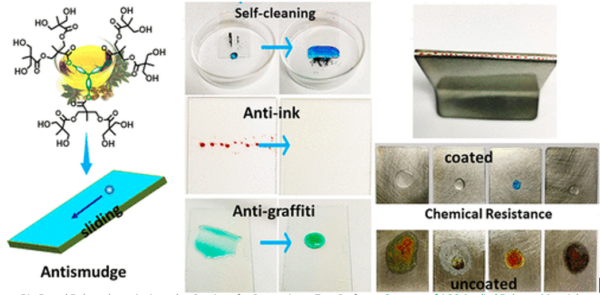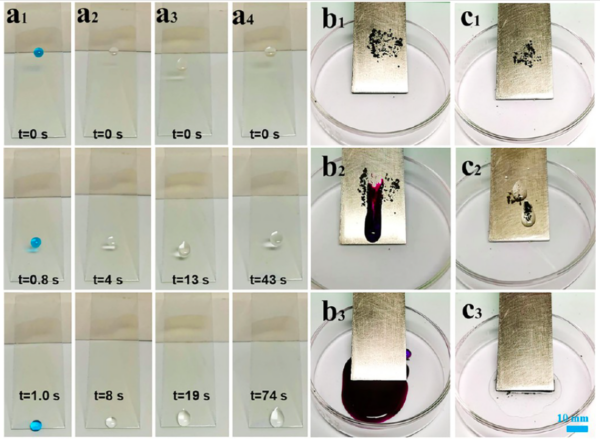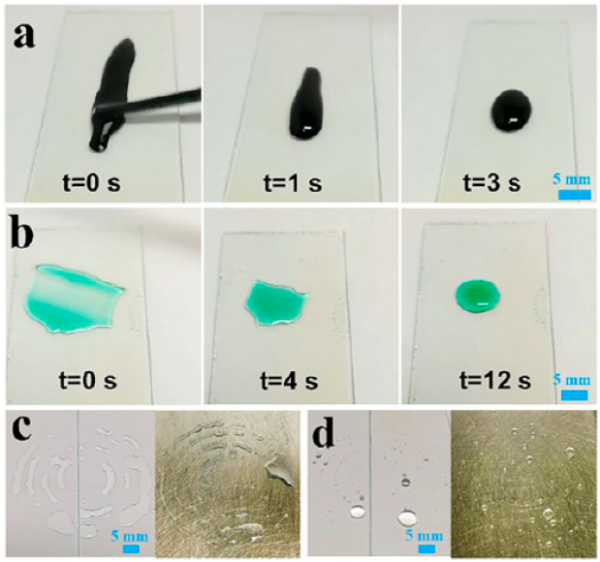Bio-Based Polyurethane for Anti-Smudge Applications

Researchers utilized hyperbranched polyols derived from castor oil as advanced cross-linking agents to develop high-performance bio-based polyurethane anti-smudge coatings.
The demand for sustainable and high-performance coatings has driven research into bio-based alternatives that lessen dependence on petrochemical-derived materials. Castor oil emerges as a viable renewable resource because of its abundance, biodegradability, and minimal environmental impact. This oil notably enhances polyurethane coatings’ anti-smudge properties, chemical resistance, and mechanical strength. This solution presents a promising sustainable option for advanced coating applications.
You can also read: Lignin Polyurethanes: Byproduct to Solution

Bio-Based Polyurethane Antismudge Coatings for Contaminant-Free Surfaces. Courtesy of High-Performance Bio-Based Polyurethane Antismudge Coatings Using Castor Oil-Based Hyperbranched Polyol as Superior Cross-Linkers.
Self-Cleaning Performance
This cutting-edge bio-based polyurethane coating showed exceptional performance in self-cleaning tests.
A methylene blue-dyed water droplet slid off the coated glass in a second, leaving no trace, unlike on uncoated glass. Similarly, a hexadecane droplet glided smoothly down the coated surface without residue, unlike the significant traces left on the uncoated glass. Cooking oils like peanut and pump oil also slid cleanly off the coated surfaces but left stains on uncoated ones. These results affirm that the coating effectively repels contaminants and maintains clean surfaces.

Photos show how droplets of blue-dyed water (a1), hexadecane (a2), peanut oil (a3), and pump oil (a4) slide on glass slides coated. Droplet sizes were 40 μL for water, 15 μL for hexadecane, and 40 μL each for peanut oil and pump oil. The tilt angle was approximately 25.0°. Rhodamine B stains were removed with water droplets (b1∼b3) and hexadecane droplets (c1∼c3) at a tilt angle of about 30.0°. Courtesy of High-Performance Bio-Based Polyurethane Antismudge Coatings Using Castor Oil-Based Hyperbranched Polyol as Superior Cross-Linkers.
Further tests involved scattering water-soluble rhodamine B dirt on coated steel sheets to simulate real-world dirt adhesion. Both water and hexadecane droplets demonstrated the coating’s superior self-cleaning properties by carrying away the dirt without leaving residue. Additionally, dripping water and hexadecane droplets removed graphite powder, a common contaminant, from the coated surfaces. These findings show the coating’s broad applicability in environments prone to oil-based pollutants. Such environments include pipeline inner walls, glass curtain walls, solar panels, and kitchen surfaces.
Ink Contraction Behavior
In addition to self-cleaning, the coating exhibited impressive ink contraction behavior. Permanent marker ink on the coated surfaces contracted into smaller beads. This property made it easy to wipe off the ink without leaving marks. Even after 1,000 writing and erasing cycles, the ink continued to contract into discrete droplets. This underscored the coating’s durability.
Antigraffiti and Anti-fingerprint Properties
The coating also performs well in terms of anti-graffiti and anti-fingerprint properties. Water-based carbon black ink and oil-based epoxy coatings immediately contracted upon contact with the coated surfaces, demonstrating effective repellency. The coating also prevented artificial fingerprint liquid from spreading and leaving unsightly marks. These properties make the coating ideal for use in high-touch areas where cleanliness is paramount.

Screenshots show (a) water-based carbon black ink and (b) oil-based epoxy clear coating (viscosity: 250 ± 10 mPa s at room temperature) contracting on the coated surface. (c) Artificial fingerprint liquid spread on uncoated glass slide (left) and tin plate (right) surfaces. (d) Artificial fingerprint liquid beading on coated glass slide (left) and tin plate (right) surfaces. Courtesy of High-Performance Bio-Based Polyurethane Antismudge Coatings Using Castor Oil-Based Hyperbranched Polyol as Superior Cross-Linkers.
Chemical Resistance
Chemical resistance tests highlighted the coating’s robustness. The coated surfaces had high contact angles with various chemical solutions. These tests indicated strong repellency and showed no visible damage or corrosion even after prolonged exposure. This chemical resilience makes the coating suitable for harsh environments.
Mechanical Robustness
Mechanical robustness is another critical aspect of the coating. Flexibility tests showed it could withstand bending without damage. The coating maintained its self-cleaning properties. Adhesion tests demonstrated strong binding to substrates. Abrasion tests confirmed the coating’s effectiveness even after 1,000 cycles of wear.
Bio-based polyurethane coating is a high-performance, sustainable solution for maintaining clean, contaminant-free surfaces. Its exceptional self-cleaning, anti-smudge, anti-graffiti, and anti-fingerprint properties are impressive. The chemical and mechanical robustness make it a valuable advancement in materials science. This promises significant benefits for both industrial and consumer use.
